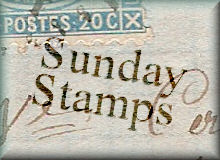
When I was young and collected stamps, I was really impressed by triangle stamps from other countries. I was used to seeing only the rectangular stamps that we had in the United States. I no longer collect stamps, but I do collect postcards that illustrate stamps.
Here I have two postcards made to be sent from stamp shows in the early 1960s. Each of these includes a triangle stamp, as well as a wide variety of topics from various countries. The first one is probably a little older than the second one which is clearly from 1963. Both have the message "Greetings from my favorite Stamp Show" printed on the back.

The first triangle stamp was the one issued by the Cape of Good Hope in 1853.

The United States didn't issue any triangle stamps until MUCH later. The first ones were the Pacifica 97 stamps issued in 1997. These were issued to celebrate the international stamp show Pacific '97. There were two stamps--a blue one featuring a sailing ship and a red one featuring a stagecoach.

The only other triangle stamp issued in the United States is the one issued in 2007 to commemorate the 400th anniversary of the Settlement of Jamestown, Virginia by English colonists in 1607. This stamp shows a painting of the three ships that carried the colonists. The first fort built by the settlers was shaped like a triangle, as is the stamp.


















































